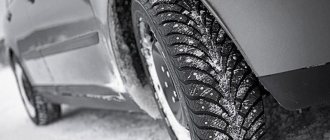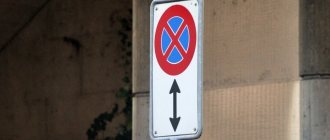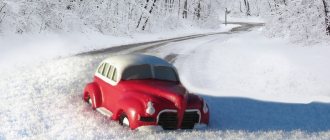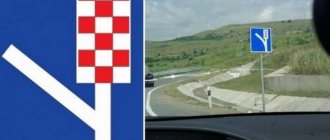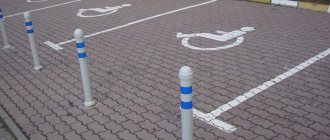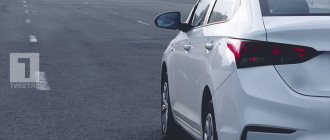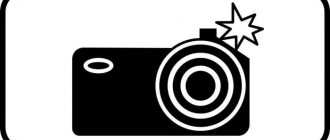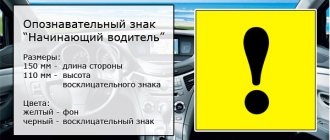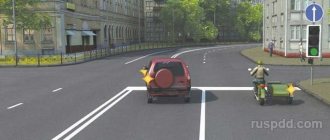On April 4 last year, changes were made to the set of road safety rules, according to which motorists are required to hang a “Spikes” sticker on cars with appropriate tires. In connection with the innovations, car enthusiasts suddenly remembered the capital letter “Ш” in the triangle. Although many modern car enthusiasts have not even heard of the presence of such a sign. Now, with the onset of the autumn-winter season, a huge number of questions arise related to the use of the “spikes” sign. For example, what is the fine for the absence of a thorn sign?
What does the Thorns sign show?
Before studying the legal part of the problem, you should familiarize yourself with the sign itself.
And first, it’s worth finding out what the “W” means on the vehicle window. Most car owners will immediately answer that “spikes” need to be stuck on so that other road users receive information about using studded wheels on their car in winter. However, this letter also has another function, directly related to the one already indicated.
Due to the properties of the studded tread, which makes it possible to stop a car much faster than a car without studs, this sign warns cars following behind to maintain an increased distance, so that in the event of emergency braking they do not get hit in the rear bumper.
It is important to determine the unsuitability of tires in time.
A tire is considered worn out when the remaining tread is at the minimum permissible value, or the rubber has any visible damage:
- small or large cuts;
- cracks in the cord;
- frame delamination;
- the sidewalls or the tread itself are swollen;
- breakdowns;
- The sides came off.
The production of studded wheels is established at many enterprises, and its quality varies depending on the manufacturer.
Therefore, the spikes tend to simply fly out from under the car. Accordingly, car owners following behind vehicles must be warned. Otherwise, you can end up with a metal product in the windshield, and with it the expensive installation of a new windshield.
Rules for installing a sign
There is clause 8 of the Basic Provisions on the admission of vehicles for operation; studded tires must be installed on the vehicle and the SPIKES badge of the new 2018-2019 model must be installed in the form of a triangle with equal sides, the side length of which must be at least 20 centimeters. The inner outline should be red. The width of the red stripe of an equilateral triangle should be equal to 10% of the length of the side of the triangle, that is, for example, if you printed a sign whose triangle length is 20 cm, then the width of the strip should be 2 cm. A large letter Ш should be written in the center of the triangle. The background of the sign should be white.
Safety requirements under the country's legislation are to protect all road users with informative signs, for example, the spike sign.
Studded wheels can cause an accident due to the fact that the driver behind a moving car did not take into account that:
- braking distance is 10 times shorter (depending on driving speed);
- Rubber spikes can fly out at certain speeds and roads, which can damage the windshield.
Is it acceptable to not have this sign?
Based on resolution number 333, the absence of a warning sign with the letter “Ш” is included in the list of faults with which the use of a vehicle is completely prohibited.
Accordingly, starting from the moment the resolution takes legal force, any traffic police officer who stops a car with studded wheels and does not find a sticker on it is empowered to:
- issue a fine for the absence of the “Spikes” sign in the amount of 500 rubles;
- prohibit the car from continuing to move until the identified defect is eliminated;
- evacuate the car.
By the way, the fine is issued by a traffic inspector on the basis of clause 12.5 of Part 1 of the Code of Administrative Offenses, according to which the driver did not comply with the conditions ensuring road safety.
On the abolition of the fine for the absence of the “Spikes” sign
Previously, the absence of the “Spikes” sign referred to malfunctions in which the operation of the car was prohibited. Therefore, the punishment for failure to comply with the requirement to install it was regulated by the relevant article of the Code of Administrative Offences:
| Article of the Administrative Code | The content of the article | Responsibility for violation |
| 12.5 part 1 | Driving a vehicle in the presence of malfunctions or conditions under which, in accordance with the Basic Provisions for the admission of vehicles to operation and the duties of officials to ensure road safety, operation of the vehicle is prohibited, with the exception of malfunctions and conditions specified in parts 2 - 7 of this article | Punishment: warning or administrative fine in the amount of five hundred rubles Cases are considered by: Internal Affairs bodies |
But since the current version of the traffic rules does not provide for the use of the “Spikes” sign, there is also no punishment for its absence.
By the way, in accordance with the Road Traffic Regulations, motorists are required to use winter tires from December to March. At the same time, by local legislation it can be either reduced or increased, because winter in Norilsk and Rostov proceeds differently.
Car enthusiasts often wonder whether the opposite situation is a violation: a “Spikes” sign installed on a car in the summer (more precisely, installed in the winter and not removed in the summer). The Rules do not say anything about installing a sign during a strictly defined period, and, therefore, this situation is not a violation, and there is no need to fear a fine. And the margin of distance that the driver driving behind will set in the presence of a sign will not hurt at all.
The “spikes” sign – where to hang it according to the rules
Based on the provisions of the current legislation, there is a clear definition of the necessary parameters of the sticker, but there is no data on the exact location of the sticker.
The only guideline for finding the letter is that it should be on the rear of the car so that the driver behind can see it.
Accordingly, most car enthusiasts try to hang a sticker on the rear window. If there is no free space in the designated area, or the sticker obstructs the driver’s visibility when moving, you can simply hang the sign on the trunk lid.
Where is the "Sh" sign placed?
The lawmaker's only requirement is that the sign must be located at the rear of the vehicle.
The rest will remain on the conscience of the car owner. We offer several recommendations:
- The sign must be visible to the road user, at least to the vehicle driving directly behind.
- The best place is the top corner of the rear window. Choose the side at your discretion based on the dimensions and design of the car.
- If you want to ensure the safety of the sign for a long time, the right solution would be to attach a triangle to the inside of the mirror.
- If there is tinted glass, it is wiser to stick the sign on the outside. In this case, choose a non-paper sign. and polymer materials.
- When purchasing, carefully check whether the sign corresponds to the established dimensions.
- To prevent the sign from leaving marks on the glass, opt for those that are attached with a suction cup rather than with tape or Velcro glue.
In principle, it is not prohibited to place a sign on the bumper. However, in the conditions of Russian roads with ubiquitous dirt and chemical agents splashed on the road surface, the sign will need to be constantly cleaned of contamination. The dimensions must be no less than those established by law, but there is no prohibition towards increasing them. Theoretically, it is allowed to stick the sign on the entire area of the rear of the car. Whether this is reasonable is another question.
Which side of the glass to glue the sign on?
As with the previous question, the legislation does not provide a clear answer or guidance.
However, to avoid problematic and controversial situations, it is best to place the sticker at the top of the rear window. There she will be better visible to others. But any side for gluing can be chosen.
Another tip concerns car owners with tinted windows. If there is a tint film on the rear window, then it is better to place the sticker with the letter on the outside. If there is no film on the glass, then the sticker can be placed inside.
Remember that the triangle with the letter “W” is best glued where the glass will be cleared of dirt and snow.
When to put up a sign
The answer to this question lies on the surface: as soon as the car has changed into studded wheels, a corresponding warning sign should appear.
In this case, the problem may appear if the car gets into an accident during the off-season, that is, in the autumn or spring. After changes have been made to the traffic rules, car owners must change tires to ones that correspond to the season outside the window.
Thus, in the fall and spring it will not be clear whether the car is driving on summer wheels, if there is no sticker, or on studded wheels. As mentioned at the beginning, a car with winter wheels has a much shorter braking distance. If the person driving such a car resorts to emergency braking, at a short distance the driver of the car behind will not be able to react in a timely manner.
In such an accident, traffic inspectors can determine mutual fault:
- The owner of the vehicle in front did not notify other road users about the studded tires installed on the car.
- The second driver will be charged with failure to maintain a distance.
This situation can create a lot of headaches when contacting the insurance company for compensation. While the first court hearing is going on, then the option of an appeal is not excluded, then the second trial will begin.
To avoid unnecessary time costs, it is better to stick a warning triangle immediately after replacing it with studded tires, even before the deadline prescribed by law. Then people in uniform will have fewer additional questions.
What if the car has Velcro?
When a vehicle is equipped with Velcro and not studded wheels, the presence or absence of the “Spikes” sticker does not concern such car owners for now. However, the option when the legislative body, with the light hand of the traffic police, resumes consideration of this issue, is very likely.
On the other hand, the introduction of a mandatory sticker with the “Ш” symbol for cars with Velcro would be quite logical, because the lip system, along with studded tires, provides a car with a shorter braking distance on an ice-encrusted road.
By the way, tests have proven that at low temperatures, the braking distance of a car with Velcro will be even shorter than that of a studded one. Accordingly, other road users must be warned in order to avoid unpleasant situations.
The main rule to follow when changing seasons:
- the “Spikes” sign on the car must appear simultaneously with the replaced summer set of tires;
- The law prohibits the use of a car with summer tires in winter.
The law also prohibits the use of studded wheels in the summer. The remaining months are the period in which the car owner himself must determine which wheels to use and he must do this based on weather conditions.
It is worth noting that in addition to the main legislative body of the country, there are also local legislators who can adopt a regional regulatory act that can either reduce or increase the periods of use of a certain type of rubber. After all, the duration of winter and summer in a region with a warm climate differs from the region where winter weather prevails.
At the same time, neither the traffic rules nor the laws provide for the responsibility of the car owner for operating the vehicle on summer tires, but with the presence of the “Spikes” sign on the glass.
This means that when the sticker remains on the glass in the summer and the set of studded wheels is removed, no one will be able to issue a fine. Therefore, there is no need to suffer and peel off and re-glue the sign in place every few months. And it is strongly recommended not to remove the sticker even in summer with new tires.
After all, none of the motorists driving behind can predict whether the car in front is equipped with spikes or not. Therefore, they will have to keep a safe distance with a margin to prevent a collision in the event of a sudden stop of the car.
“We look at each case individually.” How drivers are fined for having a “70” sticker
The material published on ABW.BY “On papers, the difference is a minute!” “A woman received two fines for 184 rubles from the cameras” caused a wave of discussions on the forum. One of the main issues was the legality of punishing a driver with more than two years of experience for speeding if he has a “70” sticker.
Some readers argued that if a “70” sticker is attached to a car, then the driver has no right to exceed the indicated speed. Others, on the contrary, were sure that when qualifying an offense it is necessary to proceed from the actual experience of the driver, and not from the stickers on the body of the car.
Previously, the question of whether a driver with more than two years of experience would be punished for speeding if he had a “70” sticker was raised more than once on the Internet, including on our website, and everywhere the answer from traffic police officers was interpreted the same way: if there is On car stickers in the form of a reduced speed limit sign “70”, the driver, regardless of actual experience, is obliged to comply with this limit so as not to mislead other road users.
The same default approach began to be used in the operation of the automatic speed limit photo recording system. It has already become a regular practice: if a car has a “70” sticker, a fine is issued to the driver for exceeding it, taking it into account.
However, many motorists are confident that the requirements of the “70” sticker on a car do not apply to an experienced driver. Is it so? Let's try to figure it out.
First, let’s carefully read the relevant clauses of the traffic rules.
91.3. The driver is prohibited from exceeding the speed indicated on the “Speed Limit” identification sign installed on the vehicle in accordance with subclause 201.5 of clause 201 of these Rules.
That is, the driver is indeed prohibited from exceeding the speed indicated on the identification sign. However, when talking about this requirement of the Rules, traffic police officers often omit its second part, which states that the sign must be installed “in accordance with subparagraph 201.5 of paragraph 201 of these Rules.” That is, it cannot be installed by everyone, but only certain categories of drivers have the right to do so. And the sign must also be attached taking into account certain requirements.
201. Vehicles must be equipped with identification marks specified in Appendix 5 to these Rules:
201.5. “Speed limit” - in the form of a reduced color image of the road sign “Maximum speed limit” indicating the permitted speed (sign diameter - at least 160 mm, border width - 1/10 of the diameter) - on the rear side of the body on the left of power-driven vehicles drivers with less than two years of driving experience, motor vehicles transporting dangerous, heavy and (or) large-sized cargo, as well as in cases where the maximum speed of the vehicle according to the technical specifications is lower than the speed defined in paragraph 89 of these Rules.
Here we see that the “Speed Limit” sign is required for installation by drivers with less than two years of experience transporting dangerous or large cargo or if the maximum speed of a given vehicle is limited by its technical characteristics.
We will not cite the above-mentioned paragraph 89 of the traffic rules in full; we will only say that it indicates the speed limits common to all road users. In accordance with its requirements, outside populated areas of the Republic of Belarus, cars and trucks with a technically permissible total weight of no more than 3.5 tons are allowed to travel at a speed of no more than 110 km/h on highways and no more than 90 km/h on other roads. Drivers towing other vehicles are not allowed to accelerate over 50 km/h; drivers who are learning to drive and drivers with less than two years of experience are not allowed to accelerate over 70 km/h, etc.
What category of drivers does the heroine of our material, who received two fines for almost 200 rubles, belong to? The owner of the car has had a “licence” for more than two years, the driver, who was behind the wheel at the time the violation was recorded, has also been driving the car for more than two years, technically, a production Lifan car has the ability to accelerate to a speed of about 170 km/h, and of course, the driver at the time the violation was recorded did not transport dangerous goods or large loads or tow another vehicle.
In fact, we have an experienced driver who decided to pass for a beginner and stuck a restriction sign, thinking that in this case he would be treated with more caution on the road. Isn’t it more logical in this case to assume that the violation is not that the driver does not have the right to drive at a certain speed, but that he has pasted a sign on the car that misleads other road users?
You can think about this dilemma, turning it this way and that, endlessly.
As promised to the members of the forum, we again contacted the State Traffic Inspectorate of the Ministry of Internal Affairs with the question: “Does a driver with more than two years of experience violate traffic rules if he moves on the road in excess of the speed indicated on the identification sign “70”, but does not exceed the speed limit set for this section of the road?
We publish the received answer in full:
“Based on Article 70 of the Law of the Republic of Belarus “On Normative Legal Acts of the Republic of Belarus”, if ambiguities and differences are detected in the content of a normative legal act, as well as contradictions in the practice of its application, the rule-making body (official) that adopted (issued) this act, or, unless otherwise provided by the Constitution of the Republic of Belarus, the body authorized by it carries out the official interpretation of these norms by adopting (issuing) the corresponding normative legal act.
In this regard, the Ministry of Internal Affairs of the Republic of Belarus, as well as the State Traffic Inspectorate of the Ministry of Internal Affairs, are not authorized to officially interpret regulatory legal acts, including to clarify or clarify the content of their legal norms.
At the same time, we provide a reasoned opinion, which is not an official interpretation of the regulatory legal act specified in this response.
In accordance with subclause 91.3 of clause 91 of the Road Traffic Rules, the driver is prohibited from exceeding the speed indicated on the “Speed Limit” identification sign installed on the vehicle in accordance with subclause 201.5 of clause 201 of these rules.
When making a decision to impose an administrative penalty on the fact of exceeding the speed of movement, recorded by special technical means operating in automatic mode, an authorized employee visually determines from a photograph the presence of an identification mark on the vehicle. If there is an identification sign, then the amount of excess speed is calculated according to the indicated sign. In case of disagreement with the imposition of an administrative penalty, the person held accountable has the right, within one month from the date of receipt, to submit a written application to the State Automobile Inspectorate at the place of residence. The said resolution will lose force on the day the application is submitted, and the administrative process regarding this fact will be conducted in accordance with the general procedure, during which the circumstances of the offense will be clarified, including the issue of qualification of the act.”
Not being satisfied with the information received in the letter, we contacted the authorized officer, but received a response that was not much different from the written one: “The decision on each issue is made by a specific traffic police officer after studying all the circumstances of the case.”
What must be the circumstances for a sticker to be ignored, and whether a driver with more than two years of experience with a sticker on his car is breaking the law by driving at a speed above 70 km/h in an area where the speed limit is 90 km/h? These questions are answered with a definite yes or No, we never heard.
As for the heroine of our material, she has not yet been able to challenge the fine. She sent a complaint to the State Traffic Inspectorate of the Minsk Regional Executive Committee by mail against the decision made by the deputy head of the State Traffic Inspectorate of the Minsk District Department of Internal Affairs. However, after some time, the answer came that the complaint was filed in violation of the established procedure, and therefore it was returned to the person who filed it. The woman also received a copy of the decision by mail. At the moment, the decision to bring her to administrative responsibility has entered into legal force, but the driver still does not agree with the violation. She twice, as written in the letter, applied for restoration of the missed deadline, but was refused. Now she has sent documents to the court to appeal the decision.
Tatiana EMELINA Photo from the editorial archive and open sources ABW.BY
Is it possible to make the necessary sticker yourself?
The problem is quite relevant, especially considering that there is now a great demand for the “Spikes” sticker, and it has become in short supply. By the way, the price tag for an ordinary piece of adhesive paper in some federal districts of the country approaches the mark of five hundred rubles.
That is, to the number that must be entered as a fine for the fact that this letter will not be on the glass. It’s a surprising fact, but in some regions, for example, the Sverdlovsk region, the heads of the territorial traffic police met motorists halfway and announced the imposition of a temporary restriction on the issuance of penalties against drivers with a missing warning triangle. However, the duration of the moratorium was not announced.
Whatever the hype, it won’t last long. However, when there is no opportunity to endure (the car is constantly in use), and traffic inspectors in the region were not as sympathetic to the problem as in the example above, then you can use a temporary replacement sign of your own making.
The most important thing is to remember that any such product that is mentioned in the traffic rules must necessarily comply with GOST or other legal acts that describe the regulations for manufacture and use:
- The sticker should be a white equilateral triangle with a red border.
- The top of the geometric figure should be directed upward. The capital “Ш” will be inscribed in this triangle.
- The sides of the specified geometric figure cannot be less than 200 mm.
- There are also certain requirements for the red border: its width must correspond to 1/10 of the side of the triangle.
- Remember also about the visibility of the sticker.
Since it is of a warning nature, other road users should be able to clearly see it from a distance of at least 20 meters. This rule also applies when traveling at night or in the evening.
If the location of the sign (rear window) is covered with a tint film, the sign must be placed on the outside.
If the car owner is able to fully meet all the above requirements, then on the global Internet you can find and print a photo of the desired sign in fairly good quality.
If it is difficult to communicate with a computer, then you can contact any company in your city that provides image printing services. They will certainly make a sticker that will comply with strict GOST standards.
But this applies more to residents of megacities. Those who do not live in densely populated cities are unlikely to encounter much excitement for the “Spikes” sign, and, therefore, it will be much easier to find the necessary symbol than to make it yourself.
Is the "Spikes" sign mandatory or not in 2021?
The legislation on the sign “Ш” comes down to the Basic Provisions for the admission of vehicles to traffic and the Code of Administrative Offences.
In the first case, the main provisions in paragraph 8 oblige the installation of the “Ш” sign on cars equipped with studded tires. In paragraph 2.3.1 of the traffic rules, the driver undertakes to maintain the technical condition of the car. The Code of Administrative Offenses provides for a fine of 500 rubles for failure to display the “Ш” sign, or, alternatively, a warning.
In April 2021, a change was made to paragraph 8 of the rules, according to which the absence of the “Ш” sign is recognized as a vehicle malfunction that prohibits movement.
The sign was invented during the Soviet Union, when the vast majority of cars did not have winter tires. This happened both due to the underdevelopment of technology and simply due to poverty. There were no other types of winter tires other than studded ones in those days, and, therefore, no other car other than studded ones was capable of stopping abruptly on an icy road.
In past decades, studded winter tires were of fairly poor quality and would just as easily lose their studs when braking, creating a hazard around them. Modern technologies have made much better progress in terms of safety and quality of studs.
Currently, there are not only studded winter tires on the market, but also so-called “Velcro.” Technical means of directional stability and anti-lock wheels help cope with skidding and braking.
If you have the opportunity to use a color printer, the “Spikes” sign can be downloaded from this link and then printed. It is advisable to do this on thick paper, for example, photo paper with a density of up to 150 g/m2, otherwise the sign will turn out to be short-lived.
If only a black and white printer is available, then we suggest downloading the black and white “Spikes” sign, and the printout will need to be modified: use a brush with red paint or a red felt-tip pen to color the edge of the sign.
Are there any other consequences if there is no “Spikes” sticker?
Not only a fine for the absence of a “Spikes” sticker can be issued by a traffic inspector if this sign is not on the car. An accident can cause much more problems, even when a car with studded wheels, but without a warning sticker, is driven into from behind.
It has already been said more than once that a sign with a letter warns the one moving behind that the braking distance will be much shorter than his.
Naturally, if there is no warning in question, then the traffic inspector has the right to admit guilt in the accident on both sides. And here the traffic rules paragraph number 9.10, which says about the need to maintain a certain distance on the road, will not even help.
But mutual fault in an accident can lead to lengthy litigation with the insurance company.
"Spikes" sign: mandatory or not in 2021?
Amendments to the rules will affect road signs. Presumably they will come into effect on January 17: they are valid for at least 6 years. Main amendments
are as follows:
- restrictions on the movement of cyclists;
- prohibition of entry without permission into designated territories;
- the disappearance of a number of familiar signs;
- restricting the movement of vehicles with huge emissions of harmful substances;
- special designation of areas adjacent to diplomatic missions;
- traffic regulation during traffic jams at intersections;
- new designation for paid parking – blue lines;
- the emergence of new signs.
The Ministry of Transport is also introducing a new sign for freight transport - 3.5 tons and above. This sign limits the size of vehicles with a weight control zone. It will be presented in 2 forms - crossed out, indicating the end of the control section, and normal, indicating the beginning of the control section.
In places that are limited by a road sign, it will be prohibited:
- pull over to the side of the road;
- drive without license plates or with dirty license plates;
- stop and turn around;
- use a searchlight and a spotlight.
At the same time, during his actions it is necessary to maintain a distance of at least 20 meters
, drive in your lane and do not violate the established speed limit.
So far, the administrative code does not contain fines for violating the norms prescribed by environmental road signs. However, fines can still be issued under Article 12.16 of the Administrative Code:
- part 1
– 500 rubles or a warning for any violations other than those listed below; - part 2
– from 1000 to 1500 rubles for a left turn, if this violates the requirements of the signs; - part 6
– 500 rubles for violating the requirements of signs that prohibit the movement of trucks in all Russian regions (with the exception of St. Petersburg and Moscow); - part 7
– 5,000 rubles for violating the requirements of signs that exclude the movement of trucks in St. Petersburg and Moscow.
Another possible trouble can be an addition to another - when someone crashes into your car from behind. As we have already said, the “Spikes” sign warns the person driving behind you that your braking distance may be much shorter than theirs. Accordingly, if there is no such warning, then the traffic cop can easily admit mutual guilt, no matter how much you poke him and the other culprit of the accident into the traffic rules book (clause 9.10 about the need to keep a distance). What this means in your further communication with the insurance company is probably unnecessary to explain.
The question is not an idle one, given that now, in the wake of the general excitement, the “Spikes” sign has become a real shortage, and its cost sometimes even exceeds the very 500 rubles that will have to be paid for its absence. In some regions, like in the Sverdlovsk region, the leadership of the territorial divisions of the traffic police even met drivers halfway and announced a temporary moratorium on the application of sanctions for formal violations.
Technical inspection
The process of carrying out a technical inspection of a car involves checking its compliance with a strict list of requirements, which are the basis for allowing the car to participate in driving on public roads.
Therefore, such a fact as the absence of a “Spikes” sticker on vehicles with studded tires may be a reason for refusal to carry out a technical inspection. To avoid problems and difficulties with completing the annual procedure, you should worry about purchasing a “Spikes” sticker in advance.
Although you can resort to the option of replacing the wheels while the vehicle undergoes a technical inspection. However, the second option cannot be called rational, since the cost of re-shoeing the car is several times higher than the cost of the sticker.
Sign "Spikes" in the Republic of Belarus
A large percentage of domestic car enthusiasts visit nearby countries in their cars. So, according to traffic rules in the Republic of Belarus, all vehicles with studded tires are required to be marked with the notorious warning triangle.
At the same time, the requirements for the parameters of the sticker, as well as for the location of its placement on the car, are absolutely identical to those prescribed in Russian legislation.
True, the first time you can get off with a warning. But for a repeated violation of the traffic rules, traffic inspectors can impose a fine of up to 1,500 rubles for driving without a “Spikes” sign.
The amendments came into effect
In the spring of 2021, the head of the Russian State Traffic Safety Inspectorate, Mikhail Chernikov, ordered the start of preparations for introducing changes to the traffic rules. The amendments were adopted in the summer and came into force in December 2021.
The following changes have occurred. From the “Basic provisions for the approval of vehicles for operation”, prescribed in the appendix to the traffic rules, the line with the requirement to accompany studded tires with a special sign was excluded. The remaining provisions regarding tires and requirements for them remain unchanged.
Therefore, this year it is not necessary to stick on the “spikes”.
Work on mistakes. Will the cameras turn off in rain and snow? More details
Sign "Spikes" in Kazakhstan
But for those car enthusiasts who visit the Republic of Kazakhstan, there is good news. Simultaneously with the introduction of the mandatory “Spikes” sign on the territory of Russia, the Kazakh authorities made changes to the traffic rules of their country, according to which such a sticker is optional when driving on roads.
According to a statement from the local Ministry of Internal Affairs, the driver can install a warning triangle on his car at his own discretion. If traffic inspectors decide to take advantage of ignorance of local laws, then you can safely point them to government decree number 667.
It was this legislative act that abolished the mandatory use of a sticker with the letter “Ш”.
“Blue Buckets”: “The “Spikes” sign does not affect the accident rate
Most car enthusiasts agree that the “Spikes” sign is another useless invention of officials. On this issue, the coordinators of the most famous community fighting rudeness and arbitrariness on the roads, “Blue Buckets,” agree with them.
Representatives of this organization unanimously express an unambiguous opinion regarding the adoption of the Law on the mandatory fixation of the “Spikes” triangle on a vehicle.
According to movement activists, the warning sign is in no way capable of influencing accident rates on domestic roads. They also believe that stories about different braking distances between studded tires and Velcro can be questioned, although all tests are provided by reputable agencies.
Representatives of the Blue Buckets believe that the introduction of a mandatory sticker was done so that the state treasury could be replenished as much as possible at the expense of motorists. After all, even the hype for the wholesale sale of stickers cannot bring in much revenue. But massive fines to vehicle owners will bring much more money.
Opinion of car owners: “The “Spikes” sticker is another reason to once again take possession of the people’s funds!”
Representatives of the above organization are also supported by the majority of car enthusiasts in the country. After all, after traffic inspectors began to massively use the opportunity to fine drivers for not having a sticker on the rear window or trunk lid, the flurry of negative emotions is only increasing every day.
Many vehicle owners consider the need to attach a “Spikes” warning sticker to the rear of the car an absurd decision. The most common opinion among drivers is that in this way the state is trying to put its hand in the pockets of ordinary people, and drivers associate the cover of accident statistics with an attempt to divert attention from the real goals of the company.
At the same time, motorists say that none of them would resist the introduction of stickers if they brought real benefits. After all, it’s not a problem to buy a sticker for little money or order it from the nearest printing house, and then hang it on the glass.
People are outraged by the complete nonsense and absurdity of this situation, since even a dozen warning triangles cannot reduce the level of danger on the road in winter until people themselves begin to comply with traffic rules.
It should be remembered that the accident situation, for the most part, depends on the condition of the road surface. And if the state treasury is trying to replenish itself thanks to the funds of car owners, then they all want the incoming funds to be spent on high-quality and timely repair work.
But the main thing is the issue of fines. Therefore, in order to avoid losing your own finances to pay fines, it is better to order or purchase a sticker.
No matter how experienced the driver the vehicle owner is, some important rules for operating a car on studded wheels should be known and constantly applied in practice.
To glue or not the “Spikes” sign in 2021: the traffic police explained everything
The requirement to have a “Spikes” sign on a car applies to all drivers without exception. But the fact is that this is not the only sign that, by the mentioned 333rd government resolution, became mandatory for the admission of vehicles to operation. Starting from April 4, 2021, a car cannot be operated if, depending on the circumstances, it also does not have the following signs: “Road train”, “Transportation of children”, “Deaf driver”, “Educational vehicle”, “Speed limit”, “Dangerous” cargo", "Large cargo", "Slow-moving vehicle", "Long vehicle" and "Beginner driver".
The automobile sign “Spikes” denotes the timely use by motorists of winter tires on wheels, which are equipped with a special tread surface - studs.
The anti-slip system allows cars to brake normally on snowy or icy roads. The length of inertial movement during braking using such wheels is reduced.
Three types of winter tires:
The appearance of the designation signaling the presence of reinforced winter tires on a car is represented by GOST in the form of a triangle, inside of which is the letter “Ш”, symbolizing the abbreviation of the corresponding word.
The plate itself and the drawing must have standard sizes. Otherwise, using the wrong dimensions will result in fines that the traffic police will issue for using a non-standard sign.
Table of characteristics of the “Spikes” sign:
| Parameter | Designations |
| Form | Equilateral triangle |
| Presence of frame | Eat |
| Frame color | Red |
| Background color | White |
| Symbol color | Black |
| Symbol | Letter "Ш" |
| Image placement | In the center of a triangle with a red border, on a white field. |
| Size standards: - length of each side of the triangle; — the width of the border is measured from the length of the side of the geometric figure. | 20 cm 1/10 |
| Optimal visibility – the visibility of the sign should be optimal from a distance. | no further than 20 m. |
Motor vehicle regulations do not require drivers to place a sign on the rear window. There is no specific location for placing the warning sign on the vehicle.
But an important detail is prescribed - it should be installed and glued only in the rear of the vehicle and it should be visible to other road users.
Such requirements imply the use of the sign for its intended purpose, when it fully fulfills its practical purposes.
On the other hand, a sticker on the rear window in the center, with a slight offset to the right or left from the center of the glass, will interfere with the driver’s view of the situation on the road.
Assessing the surrounding situation while driving along the highway occurs not only thanks to rearview mirrors and parking sensors (sonars, parking radars, rear view camera).
But you can also inspect what is going on behind the car, using just the rear window of the body. But if a sign is pasted on it, it will greatly interfere with normal visualization.
The requirements for permitting a vehicle to operate contain a provision on the mandatory use of such a sign. How to deregister a car? In accordance with the requirements of this regulatory legal act, any vehicle must have such an identification mark on the rear.
The “Ш” sticker is also mentioned in the Code of Administrative Offences. According to the norms of this legislative act, a motorist who does not comply with such a requirement is subject to administrative liability in the amount of 500 rubles.
After the introduction of changes to the traffic rules about the need to change summer tires to winter tires and vice versa at certain time intervals, many motorists were puzzled by the question of whether it is possible to drive with a “Ш” sticker during the summer season.
The Code of Administrative Responsibility does not provide for liability for the use of the “Ш” sign during the summer season. Therefore, a motorist cannot be fined if his car has such a sticker.
However, in the summer, other road users will not be able to find out whether a person is driving on studded tires or not.
Since regulatory legal acts do not contain a ban on the use of such a sticker, if a driver decides to put on winter studded tires ahead of time, he must notify others about this.
In most cases, drivers drive their cars with this sticker all year round. Such a sticker can only influence the fact that all motorists driving behind will maintain a sufficiently large distance so that in case of emergency braking they have time to stop their car. Driving on studded tires in the summer also affects the braking speed of the vehicle.
If a sign is installed incorrectly, this is equivalent to its absence. Therefore, you should familiarize yourself with the requirements for it in advance. Here they are:
- The sign has the shape of a triangle with a large red border and a black letter “Ш”.
- The length of each side of the triangle must be at least 20 cm.
- The thickness of the red border must be at least 2 cm.
Please note that recently, cases of checking a sign for compliance with size requirements have become more frequent. If assessed visually, the sticker should be the same width and height as an A4 sheet. Stores often sell smaller signs.
You can make the sticker yourself in any convenient way - the law does not prohibit this. For example:
- Print the sign on a regular sheet of paper, then laminate it or cover it with tape (so that it does not deteriorate from moisture).
- Print the sign on a black and white printer, decorate the border with a red felt-tip pen or paints.
- Draw the sign yourself, observing the proportions.
There are no restrictions, the main thing is to maintain the required dimensions. The sign is installed on the back of the vehicle: on the glass, bumper, trunk, etc. The main thing is that it is visible from afar. It is better not to glue the sign with tape or glue - it will leave marks that will be difficult to remove. Stores sell special suction cups that make the sign reusable and keep the glass clean.
The sticker indicating spikes on a car looks like an equilateral triangle. Dimensions of the sign according to GOST :
- The side length is at least twenty centimeters.
- The outline of the triangle is made in red.
- The width of the red border should be 1/10 of the width of the side - twenty millimeters.
- In the middle of the sign on a white background is a black letter “Ш”.
According to the standards, the “spikes” sign or sticker should look like this:
Other forms of signs that do not comply with GOST are not allowed. It should always be exclusively of a standard type.
Sometimes car enthusiasts simply cannot find a “spike” sticker in their city. Often this is due to hype. So, for example, on this issue in one of the regions of the country, the leadership of the traffic police went to meet drivers and temporarily declared a moratorium on the application of sanctions in this regard.
If the inspectors in your city of residence are not so loyal, you can make a sign yourself. The main thing is that it meets all GOST standards. Therefore, the sign will have to be printed exclusively on a color printer.
In big cities, there are no problems with purchasing a sign; if it is not available in the nearest store, it can be made to order. This service is not expensive and is completed quite quickly.
Car enthusiasts are often interested in whether it is necessary to hang the “Ш” sign on their car. Government Resolution No. 333, approved on March 24, 2017, allows the traffic police inspector to prohibit the operation of a car with studded tires, without a special sign. Therefore, the inspector has the right to fine the violator.
The fine for not having a spike sticker can be as follows:
- warning;
- monetary penalty - 500 rubles
The presence of a studded tire sign cannot be considered an offense if there are none. Therefore, when replacing tires from summer to winter, it is not necessary to remove the sticker. The driver will not be fined for the spike sign.
Ignoring the law, a motorist must be prepared for negative consequences if a traffic accident occurs. A driver who crashes into a lawbreaker has the right to sue, pointing out the absence of a warning sign.
Whether or not the car sign studs is required depends on the actual presence of studs on the tires. Driving the vehicle must comply with all traffic rules and respect other road users. This affects the safety of the driver and his surroundings. The legal requirement for the obligation to install the “Ш” sign is due to concerns about safety. After all, wheels with spikes can cause an accident in which people will suffer.
The “Ш” sign appeared as a designation on a car a long time ago, but its use became mandatory only in 2017. Such information should appear on all cars that are fitted with winter tires.
The fact is that a car traveling on wheels with spikes, even in icy conditions, has a shorter braking distance. That is, motorists following him need to calculate the distance to prevent an accident. Let’s decide whether the “spikes” sticker is needed.
Why was it considered important that this sticker be placed on the car? Supposedly, it allows you to avoid emergency situations, because the braking distance of a car with winter tires is much shorter than that of a similar model without studs. A driver driving behind a car with studded tires, looking at the sign, understands that he should increase his distance. But the traffic police came to the conclusion that the sticker does not cope with the mission and does not help the driver estimate the braking distance of the next studded car in front of him. Now the Ministry of Internal Affairs believes that to determine the threat, there are other criteria: the design of the car, whether it is loaded or empty, how modern the braking system is, as well as weather conditions and road conditions. Probably, it is according to them that the driver moving behind should calculate the braking speed of the driver driving in front of him. Let us remind you that before the sign was abolished, a fine of 500 rubles was even introduced for its absence in the presence of studded tires.
Important! The sticker limited the view, and if several of them are attached, for example, “newbie driving”, “disabled person”, “child in the car”, then the rear window turns into an art gallery.
Interestingly, after journalists began to calculate when the spike sign on a car would be abolished, several high-profile articles were simultaneously published that talked about speculation with stickers. Izvestia, for example, reported that the Russian Motorist Movement insists on checking and finding someone who “hit the jackpot” and earned fortunes from rush demand and exorbitant 150 rubles for a triangular piece of paper.
Many drivers agree with the abolition of the sign, believing that the assessment of the braking distance of modern cars should be done differently, and the sticker obscures the view. But there are others who still think the outdated sticker is necessary. In their opinion, the sign serves as a good and clear warning - you need to keep the maximum possible distance from this car, otherwise you risk damage to the windshield and the body of your car. Well, at the moment, every car enthusiast has the right to decide for himself whether to stick a long-suffering sticker on the rear window of his vehicle or not.
Previously, before its abolition, it was 500 rubles under Part 1 of Article 12.5 of the Administrative Code. There was no repetition of this violation, just as there were no enforcement measures - evacuation and a ban on the operation of the car. Why describe what happened before (what size is the sign, what is the fine), you need specifics, the number of the order and when it came into force, the abolition of the “Ш” sign, and not litter it with unnecessary information.
It can be fixed in any preferred place, but driving school instructors recommend placing the badge in the corner of the rear window, and it does not matter at all whether it is located at the top or bottom.
Features of studded tires
Winter car wheels equipped with studs have their own special characteristics, the main of which is hidden behind the design features of the tread. It is this part of the wheel that is responsible for ensuring the best adhesion of the tires to the road surface.
Studded tires also have lamella blocks, which improve the grip properties of the wheel and road and, accordingly, increase stability when cornering. In addition, lamella blocks significantly reduce the braking distance of the car.
Due to the presence of lugs on the studded rubber tread surface, it allows the car to overcome road sections covered with wet snow much more easily. And such sections of tires appear due to the presence of wide grooves and fairly powerful shoulder blocks.
Studded tires, which have all of the above features, have proven themselves excellent on icy roads. Using just such wheels on a car allows you to comfortably drive through the most difficult areas.
Using studded tires on a car is advisable for a number of reasons:
- resistance of products to side cuts;
- high elasticity of the tire during operation even at low temperatures;
- increased safety when driving a vehicle in winter.
By the way, the properties indicated in the second paragraph of the list appeared thanks to the use by manufacturers of a special rubber mixture consisting of silicone and natural rubber. The combination of these materials allows the tire not to tan even at high negative temperatures.
When does the law oblige you to change tires to winter ones?
First of all, let's find out which law you need to refer to when changing tires. In this case, the regulations of the customs union apply, which is the main document defining the regime for changing tires. It has been operating in Russia, Belarus and Kazakhstan since 2005. To be more specific, you need to refer to Appendix No. 8, clause 5.5, which specifies the specifics of changing tires, namely: “It is prohibited to operate vehicles that are not equipped with winter tires in the winter.” The summer winter period means December, January, February. At the same time, the service life of rubber can be increased by regional government bodies, but not reduced.
There is no specific date for changing summer tires to winter ones, but most experts recommend doing this between September and November, but no later than November 20. It all depends on weather conditions; sometimes in September you can encounter snowy roads, so replacing tires is obvious. But, if the first snow has not yet fallen in December and the air temperature is confidently above zero, this is not a reason to refuse winter tires.
Winter tire markings
Winter tires come in two types and can be used in winter (from September to May):
- studded winter tires;
- studless winter tires.
It has a marking consisting of two letters: “M” and “S”, which are connected by a “+” sign.
Using all-season tires
Those drivers who use an all-season tire should know some aspects of its operation, namely: the marking of all-season tires should consist of two letters “M” and “S”, supplemented by the signs “&”, “+” or a space between them. If these signs are not present, the use of tires will be considered an offense.
Features of winter tires
The law mentioned above regulates the tread height for winter tires - 4 mm. The tread of winter tires is characterized by high blocks and deep grooves. This is necessary for cutting into loose surfaces (dirt, sand, snow). This tire structure is not suitable for driving on wet asphalt, which is why they are relevant for the winter period.
Other choices depend on the vehicle and driving style. For winter use, you can choose winter and all-season tires. Many motorists choose all-season tires due to their attractive pricing. However, studded tires significantly improve performance on snowy and icy roads. Spikes improve traction and reduce the likelihood of accidents in winter.
Winter tires without studs can be studded. No down payment? At the same time, the front and rear wheels can be equipped with studs from different manufacturers. The main thing is that the studs on the wheel are from the same set. Sometimes already studded tires undergo additional studding to further protect the tires. A selection of winter tires can be found and compared by price on the portal https://ekaterinburg.aport.ru/.
If earlier some motorists practiced installing winter tires only on the front wheels, today such saving options are prohibited; winter tires must be installed on all wheels of the car. You need 5 winter tires, one of them should be in reserve.
Fine for breaking the law
If last year the fine for violating this law was 500 rubles, this year the law is applied to ensure the safety of vehicles and does not require payment of a monetary fine.
Drawing a conclusion, we present a table that clearly shows which tires should be used in a given period of the year.
| Winter | Spring | Summer | Autumn |
| Summer tires | |||
| Studded tires | |||
| Studless tires |
Statistics show that since last year the number of accidents has decreased by 15%, which indicates the effectiveness of the law. Changing tires on time affects not only road safety, but also the driver’s confidence while driving.
Minimum tire tread
Penalty for summer tires in winter
How I chose car winter tires
Additional Information
5.5. It is prohibited to operate vehicles equipped with tires with anti-skid studs in the summer (June, July, August).
Be sure to run in studded tires
To prevent the use of studded wheels from causing some discomfort, some special conditions should be followed during the first few weeks of using such wheels.
The most important thing is to break in a new set of tires. Such actions will improve the controllability of the vehicle, and, consequently, safety, because driving at high speed on a snowy road and with unbroken wheels can cause you to get into an unpleasant situation.
The fact is that at the very last stage of production of studded wheels, they are placed in a special mold. To make it easier to remove the finished product from it, the surface of the product is treated with a special lubricant. Thanks to the running-in of rubber in the first 300-400 kilometers, the lubricant is erased, and a rough layer appears on the surface of the wheels, which increases the coefficient of adhesion of the road surface and studded wheels and reduces the braking distance of the car.
It is important to remember that when running in a new studded set of tires, a fairly large load falls on its tread layer. Therefore, at this stage it is necessary to constantly monitor the condition of the tires.
General recommendations
An important feature of rubber with spikes is that during prolonged storage they begin to lose their properties. In order not to feel discomfort from too hard tires in the first days of winter, experts recommend replacing them before the cold weather begins. Due to this, it will be possible to return the rubber to its optimal elasticity parameter.
To properly break in new tires there are a few simple rules:
- compliance with a certain speed limit not exceeding 65-70 km/h;
- try not to press the gas pedal to the floor immediately at the start;
- choose the ideal surface for rolling in;
- try not to resort to sudden braking;
- Constantly monitor the tire pressure.
When replacing summer tires with a set of studded tires on a car equipped with a four-wheel drive system, you must strictly observe the markings on the tires. Otherwise, the owner of such a vehicle will significantly lose control quality.
Naturally, installing new studded wheels on rims that even have hidden defects is strictly prohibited.
Therefore, the re-shoeing process should take place in a specialized service, whose employees will not only check the quality of the discs, but also carry out installation along with subsequent balancing.
Studded wheels require regular monitoring not only during the running-in process, but also during subsequent operation. The result of the constant interaction between rubber and road surface is heating of the tires to maximum temperature. As a result, the wheels become softer, which can lead to the loss of studs and the rubber losing its main properties.
In order to prevent the purchase of several sets of tires in one season, as well as to protect yourself from unpleasant situations on the road associated with falling metal spikes hitting the glass of the car behind you, you should adhere to the above recommendations.
And, of course, do not forget to place a warning triangle with the letter “W” on the rear window or trunk lid.
